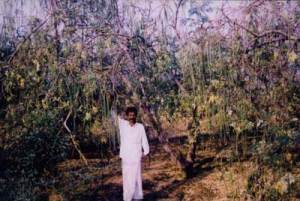
CONVINCING A farmer to use a new innovation for his crops is quite a daunting task.
One cannot blame him for his suspicious nature which he claims, acts as a protective shield for his livelihood.
“Even if an expert speaks one whole day to the farmer, he cannot convince him. But if a farmer from another place, or region interacts and speaks then almost the entire village gets convinced,” says Prof Anil Gupta, Vice Chairman, National Innovation Foundation, (NIF), Ahmedabad, (phone: 079-26753338).
Cold shouldered
Take the case of a farmer Mr. Ishwar Singh Kundu, who developed his own herbal formulation (Kamaal- 505) for crops only to be ignored and cold shouldered by his ilk until he decided to use it in his 2 acres and invite farmers to come and see the positive results themselves.
“Many times I used to leave my samples with the farmers for them to test it on their crops and after some months,
Disappointed
“I used to get disappointed because farmers did not use his product and kept his sample aside for months.
It pained him to see his product lying unused in a corner of the field.
“The very mention of the word ‘herbal’ used to irritate some farmers. I tried to explain the merits of herbal formulations on the plant and the ill effects of inorganic pesticides and fertilizers,” says Mr. Ishwar. Somehow he managed to convince some farmers and as a result sold a few thousand rupees worth of his herbal formulation. “The herbal formulation produced good results in the Kurukshetra region, a rice belt,” he says.
When initially he started developing his formulation, he tested it by spraying it on his vegetable farm.
Later he started experimenting, changed the formulation, and tried it on paddy by mixing it with the fertilizer and spreading on the ground.
Excellent results
“This technique gave excellent results,” he says.
Slowly he started reducing the fertilizer quantity mixed along with the pesticide. When given to farmers for testing, the product received a good feedback. Apart from giving good results on rice it also showed promising effects on maize and jowar crops. Mr. Ishwar is now testing it on aloe vera crops in Punjab.
“In the initial stages people used to show me a portion of their field which did not yield properly and attribute it to his formulation.”
Trying to fool
His own village farmers did not trust him and say that he boiled some leaves in water and trying to fool them.
But when farmers from other villages started using his formulation, his village people also slowly started showing interest in his work.
Giving details on how his herbal pesticide is manufactured, he says:
“I started experimenting with neem (Azadirachta indica). First, I boiled the neem leaves in water and sprayed the solution on the crops. I proceeded further as I got encouraging results. In the second phase I mixed neem oil with the solution and got even better results.”
Further development
He developed his technique further using neem leaves, neem oil, jaggery along with a couple of other herbs.
All these herbs are mixed with cow’s urine in a vessel. After fifteen days the solution is filtered and used. For more effectiveness neem leaf decoction can also be added to it.
He used a litre of herbal solution diluted in 100 litres of water and sprayed on paddy crops and obtained good results.
Good feedback
Feedback from the users indicates that it is helpful in controlling several pests, insects and termites. It acts as a pesticide, insecticide and growth promoter.
Animals also do not eat this crop because the presence of the solution on the leaves makes it taste bitter.
“The product is a good hit in the local market and is fetching steady income for the innovator. “Queries are also being received from other states also,” says Prof. Gupta.
A patent for this formulation has been filed by NIF which supports him under the Micro Venture Innovation Fund (MVIF) of NIF-SIDBI.
For more information readers can contact Mr. Ishwar singh Kundu, Krishico Herbolic Laboratories (Regd.), Village Kailram, District Kaithal, ,Haryana, email: kisan.kamaal@gmail.com, Phone: 09255544241.









